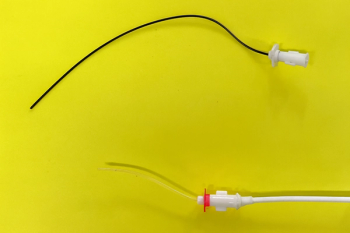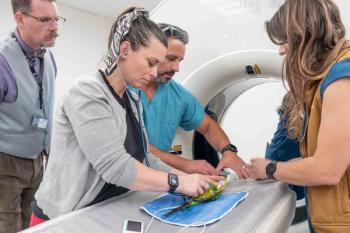
Image Quiz: What's causing this dog's painful urination?
An intervention to remove urinary stones didn't alleviate this bichon frises's stranguria. See if you can spot the cause in this ultrasonogram.
This 6-year-old female spayed bichon frise presented for evaluation of stranguria. She had undergone a cystotomy five weeks prior and two calcium oxalate stones had been removed. Urine culture results were negative at that time. Since the cystotomy, she has been posturing and urinating with a normal stream, yet continues to exhibit stranguria after the stream ends. What's your diagnosis based on this history and ultrasound images below?
(All images courtesy of Dr. Jessica Romine)
a. Persistent urolithiasis in the urethra
b. Urethritis
c. Retained suture
d. Cystitis and postoperative inflammation
The correct answer is c. Retained suture.
This bladder wall is thickened on the cranioventral border, where the cystotomy had previously been performed. There's a linear hyperechoic opacity evident in the center of the thickened area suggestive of suture material (arrow).
Coupled with a negative urine culture result and the fact that the dog had a normal urine stream rather than dribbling, it was suspected that irritation from the suture was triggering the stranguria since her bladder shrank during micturition. Cystoscopy confirmed that a loop of suture was entering the lumen and calcium oxalate crystals were already encrusting the retained suture.
A cystotomy was performed to remove the suture and thickened material, and the dog's clinical signs resolved within three days.
A suture nidus is an oft-overlooked differential for recurrent urolithiasis and should be considered in any case where stones have recurred after cystotomy, particularly if they recur quickly. The uroliths may be still attached to the bladder wall by the suture, or the suture may have broken and dissolved, leaving a free-floating stone with a small center core, visible only if cut.
In a retrospective study of uroliths formed around a suture nidus, suture-associated cystoliths made up 0.6% of canine cystoliths, including 9.4% of recurrent cystoliths. Shih tzus, Lhasa apsos and Pomeranians, as well as male dogs, were more likely to develop suture-associated cystoliths, likely owing to these dogs' increased risk of calcium oxalate stone formation.1 Dogs with suture-associated cystoliths also had stone recurrence sooner than dogs with non-suture-related cystoliths because the suture provides an excellent nidus.2
To minimize iatrogenic urolith formation, the American College of Veterinary Internal Medicine (ACVIM) consensus on uroliths is to use suture patterns that minimize suture exposure to the bladder lumen and to attempt medical dissolution of struvites and minimally invasive procedures when available.3
References
1. Appel SL, Lefebvre SL, Houston DM, et al. Evaluation of risk factors associated with suture-nidus cystoliths in dogs and cats: 176 cases (1999–2006). J Am Vet Med Assoc 2008;233:1889-1895.
2. Kaiser J, Stépánková K, Kor Istková T, et al. Determination of the cause of selected canine urolith formation by advanced analytical methods. J Small Anim Pract 2012;53:646-651.
3. Lulich JP, Berent AC, Adams LG, et al.
Jessica Romine, DVM, DACVIM, is a small animal internal medicine specialist at BluePearl Veterinary Partners in Southfield, Michigan. She has a special interest in interventional radiology and advanced imaging procedures.
Newsletter
From exam room tips to practice management insights, get trusted veterinary news delivered straight to your inbox—subscribe to dvm360.






